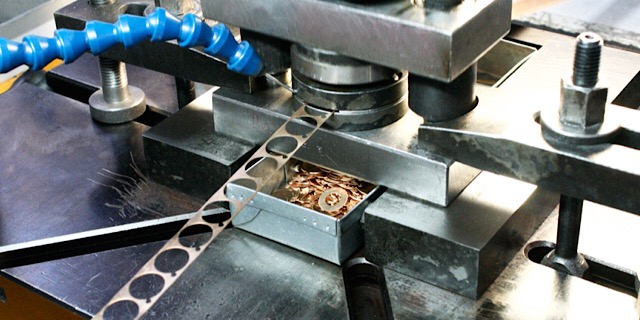Advanced Metal Stamping Methods for Precision Production
Advanced Metal Stamping Methods for Precision Production
Blog Article
Steel Marking Developments: Elevating Manufacturing Processes for Superior Outcomes
In the realm of producing processes, metal stamping has long been a foundation strategy for producing a selection of precision components. With the ruthless march of technical innovation, the landscape of metal marking is undergoing a substantial improvement.
Advancement of Steel Marking Methods

Furthermore, advancements in material science have resulted in the advancement of high-strength alloys that can currently be flawlessly marked into complex shapes, catering to a broader variety of industrial applications. The combination of robotics and expert system has actually better maximized the stamping process by improving speed and accuracy while minimizing the threat of human mistake.

Influence of Advanced Materials
Have sophisticated products transformed steel stamping processes significantly in the manufacturing sector? By utilizing materials such as high-strength alloys, progressed compounds, and ingenious layers, steel marking procedures can now create elements that are lighter, stronger, and extra long lasting than ever before.
These sophisticated products offer superior mechanical residential properties, corrosion resistance, and thermal security, enabling suppliers to satisfy the needs of contemporary markets such as aerospace, auto, and electronic devices. In addition, using sophisticated products in steel marking has promoted the production of complex geometries and elaborate styles that were formerly unattainable via typical techniques.
In addition, the execution of advanced products has caused lowered material waste, lower manufacturing prices, and shorter lead times, making steel stamping procedures more lasting and affordable. As innovation remains to breakthrough, the impact of innovative materials on metal stamping procedures is expected to drive more technology and improve the competitiveness of makers in the worldwide market.
Automation in Steel Stamping
The development of steel stamping processes driven by the integration of sophisticated products has established the stage for substantial advancements in automation within the production industry. Automation in metal marking has transformed manufacturing processes, enhancing efficiency, precision, and general outcome top quality. With the use of robotics, sensors, and computer-controlled systems, jobs that were lengthy and when hands-on can now be executed with exceptional speed and precision.
Automation in steel marking not only accelerates production prices however additionally guarantees uniformity in the production procedure. By minimizing human treatment, the risk of mistakes is substantially minimized, bring about greater levels of item uniformity and integrity. In addition, automation makes it possible for manufacturers to embark on intricate marking jobs that would certainly be tough or not practical to accomplish by hand.
Additionally, automation in steel marking adds to a much safer working environment by minimizing the demand for workers to participate in repeated or unsafe tasks - Metal Stamping. This shift towards automation not just enhances efficiency however additionally leads the way for the future of manufacturing, where innovation plays a central function in driving functional excellence
Quality Control and Examination Equipments
With an emphasis on precision and integrity, quality assurance and examination systems play a crucial role in making certain item excellence in metal stamping procedures. These systems are designed to monitor every phase of production, from product inspection to the final product, to ensure that all components satisfy the called for standards. By applying innovative technologies such as optical evaluation systems, coordinate measuring machines (CMM), and automated evaluating equipment, suppliers can spot also the smallest discrepancies in dimensions, surface area high quality, and total stability of stamped components.

Sustainability Practices in Metal Stamping
Building upon the foundation of precision and integrity developed through high quality control and examination systems, the assimilation of sustainable methods in metal stamping processes is increasingly coming to be a focal point for suppliers seeking to lessen environmental impact and enhance source utilization. Sustainability techniques in metal marking incorporate a variety of efforts targeted at reducing waste generation, power consumption, and you could look here greenhouse gas discharges throughout the manufacturing procedure.
One secret aspect of sustainability in metal stamping is the fostering of eco-friendly materials and technologies that advertise recyclability and waste reduction. By using recycled materials and applying energy-efficient machinery, makers can reduce their carbon impact and add to an extra sustainable manufacturing cycle. In addition, optimizing production procedures to decrease product waste and power use not just profits the environment yet additionally leads to cost savings for businesses in the future.
Additionally, the execution of lasting methods in steel marking can improve brand name reputation and attract ecologically aware consumers. As sustainability continues to acquire value in the production industry, integrating green efforts right into steel marking processes is essential for lasting success and competitiveness in the marketplace.
Conclusion
To conclude, steel marking strategies have significantly advanced over time, including advanced products and automation to this post improve making processes. Quality control and inspection systems play an important function in ensuring exceptional outcomes, while sustainability methods are significantly being executed to lower ecological influence. These innovations in steel stamping have actually reinvented the industry, bring about much more sustainable and reliable manufacturing techniques for numerous sectors.
Metal stamping, as soon as a handbook and labor-intensive procedure, has actually changed into an extremely automated and advanced approach of shaping metal sheets into different kinds and layouts.Have advanced products changed steel stamping procedures dramatically in the manufacturing market? By using materials such as high-strength alloys, advanced compounds, and ingenious finishes, metal stamping procedures can currently produce elements that are lighter, more powerful, and extra resilient than ever previously.
The development of metal marking procedures driven by the combination of sophisticated materials has set the stage for significant improvements in automation within the production sector.In verdict, metal marking techniques have substantially progressed over time, incorporating innovative materials and automation to improve producing processes.
Report this page